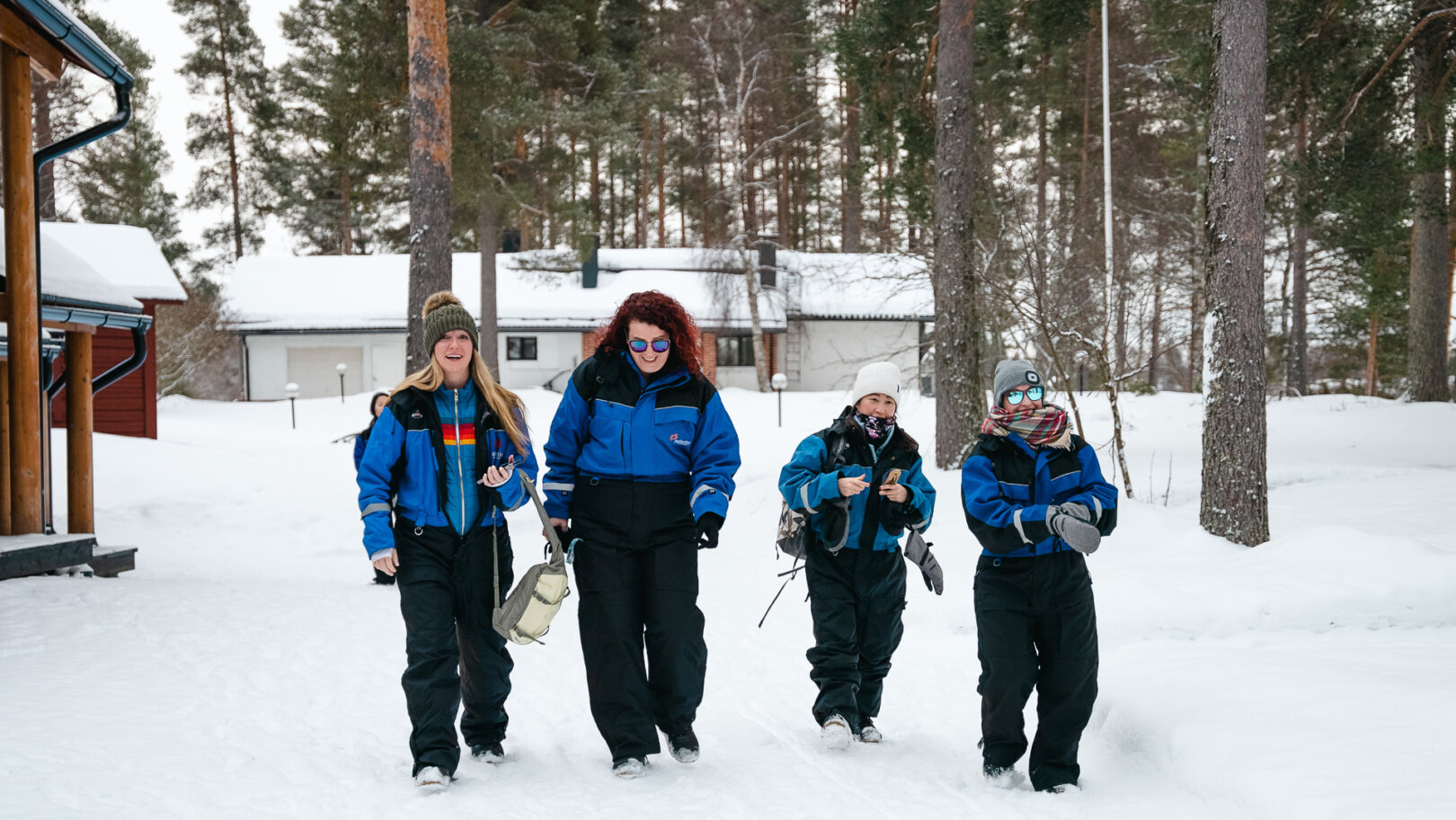What is a sabbatical? How to take time out from your job

Following the coronavirus pandemic, people have been starting to review their priorities and work situations. While millions of people have become part of the ‘Great Resignation’, the idea of just pressing pause on the grind is more appealing to others. So what does it mean to take a sabbatical?
Arranging an extended period of time away from full-time employment takes careful planning. You need to save up enough money to cover yourself and arrange to use your break in a way that makes it worthwhile. You also need to get permission from your employer to take any sabbatical leave.
However, with the working world changing, employers are more receptive than ever to creating a better work-life balance. Taking a sabbatical is now often seen as a sign of verve and proactivity. Taking a career break is your chance to press reset and fire up your creativity – you may even learn a new skill or change careers completely. Here we cover everything you need to know about how to take a sabbatical and plan to ensure you get the most out of your experience.
What is a sabbatical?

A sabbatical is an extended period of time away from work – a career break or a grown-up gap year. When you take sabbatical leave, you pause your job to focus on other projects, before returning again to full-time employment. It needs to be agreed in advance with your employer as they will need to keep your job open for you on your return. Sabbaticals are typically used for personal development, travel, voluntary work, or simply as an opportunity to take time out and reflect.
Why take a sabbatical?
Taking a sabbatical is also a great opportunity for self development, giving you the chance to experience new things that you wouldn’t be able to achieve while working full time, like learning new skills, finding headspace, and even expanding your career.
As well as giving you the chance to take time out and experience new things, taking a sabbatical offers lots of long-term benefits. In a world where we’re forever taught to push for more and better, sabbatical leave is a rare chance to step off the career ladder and breathe. With extended time away from the rat race, you might see life in a whole new light.
Be prepared for your creativity to skyrocket and your energy to go into overdrive. You really have no idea what you are capable of until you give yourself the chance to try. Untethered from the demands of everyday life, there’s no limit to what you can achieve. Used wisely, taking a sabbatical is attractive to future employers, too. If you can show you’re the kind of person who is proactive, curious and courageous, that can only be a good thing.
How long is a sabbatical?
A sabbatical can last anything from three months to a year. The length of a sabbatical depends on how much money you have, what you plan to do with your time, and what terms you have agreed with your employer. Around four months is a typical length for a sabbatical, and more than a year is rare – not only because of the cost of it, but also the logistics of arranging temporary cover while you’re away.
Do you get paid on sabbatical?
It’s quite rare to be paid while on sabbatical. In most instances, your employer will pause your salary and associated benefits for your leave period. People usually self-fund their sabbatical by budgeting and saving enough cash to cover their day-to-day costs while they aren’t receiving a salary.
Some companies do have policies in place for paid, or partially paid, sabbatical leave. This often takes the form of a job benefit that employees can access after a certain number of years in service at a company. A sabbatical paid for by your company typically lasts around one to three months, and there may be a limit on how frequently you can take it, such as every three years. If they’re funding your sabbatical, you may be required to participate in volunteer work with a charity or foundation that your company has partnered with. Some companies allow you to spend your time however you choose for personal growth and development.
How to take a sabbatical?

There are two stages to taking sabbatical leave, and they overlap with one another. You need to get approval from your work to take sabbatical leave, and you need to plan and prepare for your trip.
It’s worth doing some preliminary research around your sabbatical (what you will do, and for how long) before you approach your employer. But equally, your plan cannot fully take shape until you’ve negotiated time out with your line manager or boss.
There’s no single answer on what to do with your sabbatical – the world is your oyster. The main point to consider is that whatever you choose should help with your personal development in some way. This could be anything from learning a new language or skill to providing a fresh perspective and experiencing a different rhythm from your 9-5.
People take sabbatical leave for many different reasons. Working out what you want to achieve with your time away will help you decide where to go and what to do. Remember that you’ll need to explain any time away from work in future job interviews, so your sabbatical should be purposeful, and look good to prospective employers.
Travel
The great thing about travel is that it ties in with so many other areas of life, too. Maybe this is your cue to pursue a major physical challenge, like hiking in the Everest foothills. Perhaps it’s about regaining headspace with beachside yoga in Kerala. You could head to Colombia and enroll in Spanish school while you’re there. Or, you can simply hop from place to place, exploring downtown Havana one minute and sailing around the straits of Zanzibar the next. If this seems daunting to tackle alone, you could always join up with a group of like-minded travelers.
Work and travel
Obviously, traveling the world is not cheap, so you may choose to combine it with work placements. This comes with the added advantage of really getting to know a place, and living like a local. Depending on where you choose to visit, and how long for, you may also be required to work as part of your visa terms.
If your current role can be done remotely, you could grab a taste of the digital nomad lifestyle in hubs such as Ubud in Bali or Colombia’s Medellín.
If you’re looking to take a step away from your current role or try something new, a sabbatical is a great time to test the waters. You might take a TEFL qualification and teach English. You could also pick up resort or summer camp work. Jobs such as babysitting and bartending offer scope for casual work on the move, so you can make money as you go. Just make sure you have the relevant checks and references in place beforehand.
Volunteering
Volunteering is another great way of really getting under the skin of a place during a sabbatical, while giving something back at the same time. You might choose to partner with an organization that utilizes your professional skills (e.g. Médecins Sans Frontières), or volunteer in an area that you feel passionate about. Animal rescue, conversation, child welfare and teaching are all popular placement options. Sites such as Go Abroad have a good selection of projects to get started with.
Further training
A sabbatical is also a chance to develop your skill set. You could do anything from learning how to landscape paint in the hill towns of Andalusia to qualifying as a dive instructor in Thailand. You could also learn a language abroad, or study at a foreign university. Training like this could just be for fun, or it may signal the beginning of a whole new career.
Fulfill a lifelong ambition
It’s so unusual that we have unscripted time to do as we please. Another way of making the most out of your sabbatical could be to fulfill that goal you’ve always dreamt of. Perhaps it’s something physical, like climbing to the summit of North Africa’s highest mountain. Or it could be that you use your sabbatical to write that novel you have simmering away in the back of your mind. Whatever your ambition is, a sabbatical could be the time to honour it.
Where to go on sabbatical

Where you go on sabbatical depends on what you want to do. Some destinations naturally lend themselves better to different goals. Also bear in mind the price of living; big cities such as Cape Town or Singapore will be more expensive to live in than more remote destinations, and Southeast Asia will be cheaper than North America, and so on. In a digital age, it’s easier than ever to set up options for homestays, house sitting and even job exchanges to cut costs along the way.
Finding headspace
Look to the open landscapes of India for practicing yoga in Kerala, or taking a slow boat down the Mekong in Laos. Africa also offers plenty of opportunities to clear your mind, whether you’re on safari in the Serengeti, or hanging out on the beaches of Morocco.
Learning a language
If you have a specific language in mind, the destination for your sabbatical practically chooses itself. Just looking to learn something new? Let destinations in Europe, Central and South America be your guide. Learning a language on sabbatical is a good chance to party and make friends at the same time, so a lively town or city could be your starting point – check out places like Santiago, Havana, Naples or Berlin.
Volunteering
There are lots of options for volunteering in Africa, Asia, Central and South America that will give you the opportunity to really make a difference to the lives of local people. Ultimately, where you choose to volunteer depends what you want to do, and where your skills will be best matched, as well as any personal connections to a certain cause.
Living and working
Canada, Australia, New Zealand and Europe are all good for English-speakers who want to pick up contract work on the move. If you want to teach English, you can throw the net wider to places such as Japan, China, or really any major city where the demand will be high. Remote working can, of course, be done anywhere – but some places such as São Paulo in Brazil, or the Portuguese capital Lisbon have thriving remote communities with readymade support networks in place.
A fresh perspective
If you really want to shake things up, opt for a destination that delivers a bit of a culture shock. This might mean heading somewhere quite off-the-radar like Oman: the new adventure capital of the Middle East. Or it could involve immersing yourself in a sensory overload, in a city such as New Delhi or Beijing. Keep an eye out for opportunities that open up an entirely new way of living, whether that’s a spiritual pilgrimage to the temple valleys of Bhutan, or living with Dukha reindeer herders on the plains of Mongolia.
How to request a sabbatical from work

Once you’ve got an idea in mind about what to do on sabbatical and where, it’s time to run your plan past your boss. Taking a sabbatical requires the support and cooperation of your employer, which isn’t a given. Don’t make the mistake of booking any travel or accommodation before you’ve been given the green light from your employer, or you could end up losing the money you saved so hard for. Here’s how to negotiate sabbatical leave with your work.
Check your company policy on taking a sabbatical
Start by checking with HR to see if your company has a policy on taking sabbaticals. If they do, this will form the basis of your negotiations. It’s also reassuring to know that there is a protocol in place so your request won’t be met with too much surprise or confusion.
Go in with a plan and be purposeful
Before you meet with your boss to request time off, it’s crucial that you have a clear idea of how long you’ll be off and what you want to do. Taking a sabbatical can be disruptive for employers; they may have to arrange cover or work out how to hand over projects you’re working on for the period of time you want off. Being upfront and offering specific details wherever possible will reduce the uncertainty and make it easier for both parties to commit to the plan.
To help make the idea more attractive to your employer, consider how your sabbatical could benefit them. Even if you’re just planning to travel, you can make the case for how fresh energy and perspective will boost your job performance.
It’s not all one-sided, either. With more and more companies recognizing the need for a better work-life balance, many employers are now more open to the benefits of taking time out.
Be confident and present solutions
Like any negotiation, you should be confident and strong when asking for sabbatical leave. Anticipate any disruption that taking a break might create, by proactively presenting your boss with a series of solutions. For example, who will cover your work while you’re away? Maybe this is an opportunity for an ambitious junior colleague to step up into the role and flex their skills. The more you can preempt any problems, the stronger your case will be.
Be prepared to compromise. Unless your company has a set policy in place, there’s no guarantee that your request for a sabbatical will be approved. You may have to be flexible in terms of the amount of time you take off or when you take it. Bear in mind that your boss will probably need some time to consider your request, too. It’s a good idea to craft a follow-up email outlining key points, but don’t push your case too much – give your employer the space they need to make a decision.
Give plenty of notice and be mindful of timing
Timing is key when it comes to taking a sabbatical. You need to plan well ahead in asking for leave – ideally, at least six months before your intended departure date. This will allow you and your employer plenty of breathing space to prepare and hand over your work.
Also, be strategic. Try to time it at a point of natural pause in your workflow, such as after an important deadline or launch. If your work is always full-on, aim to avoid taking a sabbatical during a busy time of year for the company. Getting your timing right shows your employer that you’re being responsible and respectful with your sabbatical request.
Get everything in writing
Make sure you get any agreement for sabbatical leave in writing. In a perfect world, this will take the form of a contract that’s approved by your boss and HR department. Anything less formal means you’re not fully protected when it comes to returning to your job. No matter what reassurances your boss gives, a lot can change in a few months, so you need to ensure that you’re covered.
Stay in touch
When you’re away, don’t be a stranger to your team. Offer to be available to deal with urgent requests if needed, even if you can’t respond straight away. You don’t need to switch on your laptop every day (that would defy the point of a sabbatical) but sending regular updates and photos is a nice way to show your appreciation for the opportunity to take an extended leave of absence.
Plan a handover meeting a few weeks before your return date, read up on industry news, and book in for any relevant training to make sure your skills are fresh. Be as proactive as possible in handling a smooth transition. For more ideas to support your case, read 4 reasons why your boss may say “yes” to a career break.
How to save money for a sabbatical

Taking a sabbatical requires savvy financial planning and some serious saving, but it can be done. Once you’ve decided what to do on sabbatical, where, and for how long, it’s time to start putting a bit of money aside.
Work out the total cost
First, work out a grand total that will cover your entire sabbatical. Account for everything from big costs (flights, accommodation and course fees), right down to the daily essentials (everyday food and spending money), and don’t forget to budget for a few extras or emergencies. This sum – your escape fee, if you like – will dictate how much you need to save, and how long it will take you to reach your goal.
Set yourself a budget
Any attempt to save money involves some amount of sacrifice, so you’ll need to figure out where you can cut back. You’ll be amazed at how much you can save just by getting rid of luxuries, such as your daily coffee or gym subscription. Costly nights out and restaurant meals are also likely to take a backseat while you save, but just focus on the Colombian beach views you’ll get in return.
Consider your living arrangements
Your mortgage or rent will take up a big chunk of monthly outgoings, so this is a key area to consider when saving for sabbatical. There are lots of ways to minimize your living costs such as taking on a roommate. You might want to rent out your home while you travel to offset the cost of your sabbatical, so think twice about selling up and staying with a friend or family member, even if you’re going to be out of the country for a year.
Top up your income
You can also raise money on the side, by eBaying your wardrobe or taking on an evening freelance job. Don’t forget you can make money as you travel, too, either through a permanent position (say, being an au pair in Paris), remote working for your current role, or with casual on-the-go jobs. Find out more on how to fund an adventure.
Planning your sabbatical

Once you have a sabbatical plan in place and are making good progress with saving money, it’s time to nail down the details and start making everything official. The two main considerations for planning your sabbatical are getting everything booked, and figuring out all those pesky logistical details.
Make your bookings
Now’s the time to finalize the major elements of your sabbatical leave. You don’t need to go overboard and plan out every moment of your trip, especially if you’re visiting a few different places during your sabbatical, but make sure to get the essentials locked in.
Travel
It’s always a good idea to leave a little flex room when you do this. If you’re teaching English in Kathmandu, for example, factor in a few extra weeks at the beginning and end of your stay. This will give you time to get to know your setting. If you’re traveling between places, give yourself some extra leg room in between stops. Some of the best things that happen on the road are unexpected, so avoid the mistake of overscheduling.
Accommodation
You’ll need to have somewhere to stay while you’re on sabbatical, so try to get this sorted as early as possible. Again, it’s nice to have a little spontaneity, but it’s also nice to have a roof over your head at the end of a long day. There are lots of options for accommodation, from house sitting and homestays to hostels and hotels. What’s important is to choose something that fits your budget and aligns with your goals for the sabbatical.
Courses & activities
If your sabbatical focuses on self development, you might want to attend formal courses or workshops. A little structure is important when learning a new language or skill, and attending regular classes gives you lots of opportunities to meet people and make friends. Remember as well to book in some fun activities to see the sights and experience the unique things your chosen location has on offer.
How to take care of last-minute logistics

A sabbatical tends to mean anywhere from several months to a year away from home, so there are lots of important essentials to take care of before you go. These are the things that will help you to make sure your trip goes smoothly and that everything will be under control while you’re gone.
Home
For instance, who’s looking after your home when you’re away? Whether you ask someone you trust to house sit or simply pop in from time to time, you’ll need to leave them a set of keys and instructions about taking care of plants, what to do with your mail, and any important security information like an alarm code. If you have a lodger, make sure to prep your home in advance so everything is ready for them. And give your neighbors a spare set of keys for emergencies.
Money
To make sure you’re not spending money unnecessarily, cancel any utilities and subscriptions that you won’t need while you’re away. Let your bank know that you are travelling, and apply for a good credit card without overseas transaction fees. Make sure you have some local currency and pack your cards and cash separately to make sure you’ve still got access to money if one of your bags gets lost. Consider using an RFID blocking holder to keep your cards safe from contactless fraud.
Insurance and healthcare
Make sure you’re insured for all destinations and activities, including comprehensive healthcare coverage. If you take prescription medication, make sure you have enough to last for the duration of your trip. It’s a good idea to get a doctor’s note that you can take with you when traveling, particularly for controlled substances, such as stimulant-based medication. Research your destinations to check whether you need vaccinations or other precautions, such as malaria medication. Visit your local health center at least six weeks before you travel to get these sorted.
Phone
Your mobile phone may not work in all countries, and even if it does, your local carrier will charge additional fees for international calls, messages and data – and they won’t be cheap. Pre-order or arrange to collect a local SIM card at your destination airport, so you can use data without the sky-high prices. Make sure you have a valid passport and visas are arranged in advance. You may need a working visa if you’re planning to get a job at any point in your travels. Take photos of your visa and the ID page of your passport and make sure you’ve got them saved on your phone, along with important numbers, including local emergency, embassy and insurance numbers.
But, most of all, grab the opportunity with both hands and enjoy it. It’s time for a big solo adventure.
Find your dream sabbatical getaway with Flash Pack

As our trips are exclusively for people in their 30s and 40s, we provide the ideal adventure vacations for professionals who are on sabbatical. We give you the opportunity to step outside your comfort zone, do things differently and have new – and unique – experiences.
Discover our full range of solo adventure trips or explore the different types of group trips that we offer. Join Flash Pack today with other like-minded travelers.
Got a story or adventure that could inspire a solo traveler like you? Tag @flashpack on social or email [email protected] to be featured.
Images: Flash Pack










